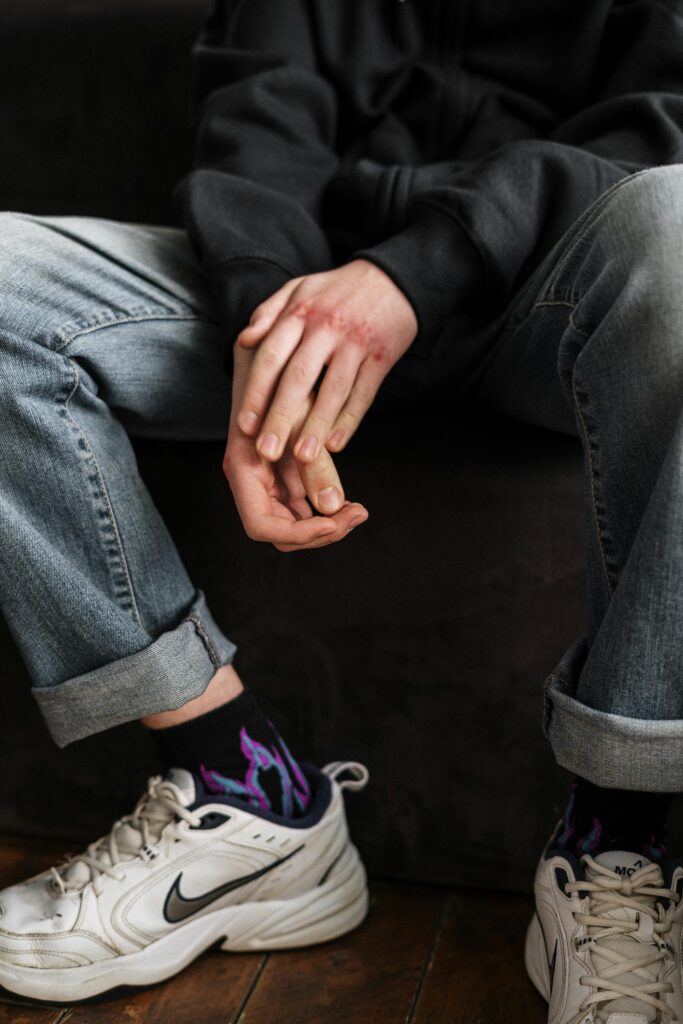
Self-harm, also known as self-injury, refers to the intentional act of causing harm to oneself. This behavior is often a way for individuals to cope with overwhelming emotional pain or distress, demonstrating a need for healthier ways to find relief. While self-harm may provide temporary relief, it is not a healthy or sustainable long-term solution to manage difficult emotions. Self-injure behaviors can also interfere with the development of healthier coping mechanisms.
What is Self-Harm and Why Do People Self-Harm?
Definition of self-harm
Self-harm encompasses a range of behaviors, including cutting, burning, hitting oneself, or engaging in risky behaviors that can cause harm, often as behaviors people harm themselves with a few times and then stop or, concerning, self-harm can become a recurring issue. It is important to understand that self-harm is a coping mechanism rather than a suicide attempt. However, people who self-harm often experience a range of emotional distress.
Reasons people engage in self-harm
People self-harm for various reasons, such as to release emotional pain, to feel a sense of control, to punish themselves, or to express feelings that they cannot put into words. It’s a complex issue that sometimes persists for times and then stops, but each case needs to be approached with sensitivity. It is essential to recognize that self-harm is a signal that deeper emotional issues need to be addressed, often indicating that the urge to harm oneself stems from unresolved internal conflicts or trauma.
Link between self-harm and mental health problems
Self-harm is often associated with mental health conditions such as borderline personality disorder, depression, anxiety disorders, or eating disorders, highlighting that self-harm is not a mental illness but rather a symptom of underlying issues. It is crucial for individuals who self-harm to seek professional help to address the underlying mental health issues.
How to Get Help for Self-Harm and Suicidal Behavior
Seeking professional help
If you or someone you know is struggling with self-harm or suicidal thoughts, it is vital to talk to a trusted adult or a mental health professional as self-harm occurs most often among teenagers and young adults. Seeking help is a crucial step towards recovery and finding healthier ways to cope with emotional pain.
Resources and support are available for individuals who self-harm
There are various resources and support systems in place for individuals who self-harm, including therapy, support groups, and helplines, which may recommend tailored approaches to healing. It’s important to remember that medical and mental health support can provide alternative ways to cope with emotional pain. while these resources are invaluable, a therapy site should not be used as a substitute for professional care, signaling the need for comprehensive medical and mental health support. Talking to someone about your struggles can provide a sense of relief and help you navigate through challenging times, especially for teenagers and young adults who often resort to self-harm.
Support for individuals with suicidal thoughts
If you are experiencing suicidal thoughts, it is essential to reach out for help immediately. Self-harm and suicidal thoughts are serious indicators that you may be at a higher risk of attempting suicide, and professional help can offer the support and intervention needed. You are not alone, and there are professionals who can assist you in finding ways to cope with the emotional pain and prevent self-harm or suicide attempts. Remember, self-harm in the teen or early adult years requires particular attention.

Understanding Myths About Self-Harm
Common misconceptions surrounding self-harm
There are several myths surrounding self-harm, such as it is attention-seeking behavior or that only people with mental disorders engage in self-harm. It is crucial to debunk these myths to provide a better understanding of why individuals self-harm and to recognize that self-harm can also be a sign of more severe problems.
Dispelling myths about self-harm
Self-harm is not a choice or a sign of weakness, but a coping mechanism for dealing with overwhelming emotions. It is essential to educate others about the complexities of self-harm and offer support and compassion to those who are struggling.
Educating others about the realities of self-harm
By raising awareness and dispelling myths about self-harm, we can create a more supportive and understanding environment for individuals who are dealing with self-harm. It is crucial to offer empathy and non-judgmental support to those in need, particularly to young people who self-harm, as understanding and compassion can be pivotal in their recovery process.
Identifying Different Forms of Self-Harm
Different ways individuals may self-harm
Self-harm can take various forms, including cutting, burning, scratching, hair-pulling, or substance abuse, and people have described these actions as ways to cope with emotional pain. Recognizing the signs of self-harm is essential to provide help and support to those who are struggling, promoting self-injury awareness and understanding. Self-harm can take on many different forms, from cutting and burning to hitting oneself or pulling out hair. Some people hurt themselves in more subtle ways, such as picking at skin or refusing to eat. It’s important to remember that self-harm isn’t always physically noticeable. For instance, wearing long sleeves or pants even in hot weather can be a sign that someone is trying to hide scars from self-harm. For some individuals, self-harm as a way to cope with emotional pain or trauma. This can be particularly true for those who have experienced post-traumatic stress disorder, a medical and mental health issue often related to self-harm or other forms of trauma that could have contributed to the urge to self-injure, especially considering how people who have experienced significant stress or unstable family environments may be more prone to self-harm. self-harm usually starts in the teenage years and can continue into self-harm tends to begin in the teenage years and can continue into adult years, making early intervention crucial.. Many people who self-harm lack effective problem-solving skills and may benefit from mental health counseling to address the underlying issues driving their behavior. If you or someone you know is struggling with self-harm, do not hesitate to reach out for help. You can call or text 988 for immediate assistance.
Recognizing signs of self-harm in oneself or others
It is vital to be aware of the signs of self-harm, such as unexplained injuries, wearing long sleeves even in hot weather, or isolating oneself. If you suspect that someone you know is self-harming, approach them with care and offer your support.
Impact of self-harm on physical and psychological well-being
Self-harm can have serious consequences on both physical and psychological well-being, and those who self-harm are at a higher risk of attempting suicide, highlighting the critical need for medical and mental health support. It can lead to infections, scarring, and long-term emotional difficulties if left untreated, emphasizing the importance of medical and mental health intervention. Seeking professional help is crucial to address the underlying issues.
Dealing with Urges to Self-Harm and Finding Alternatives
Coping strategies for managing the urge to self-harm
When faced with the urge to self-harm, it is essential to have healthy coping mechanisms in place, as effective ways to find relief and manage emotional distress. This may include deep breathing exercises, writing in a journal, practicing mindfulness, or seeking support from a therapist or support group.
Healthy alternatives to self-harm
Instead of resorting to self-harm, individuals can explore healthy alternatives such as exercise, painting, listening to music, or engaging in activities that promote relaxation and self-expression, embracing new coping strategies to deal with emotional pain. Finding positive ways to cope with emotional pain is crucial for recovery, especially for people who self-harm often as part of their struggle to handle overwhelming emotions, leading them to seek new coping mechanisms.
Seeking help in moments of crisis or intense emotional pain
If you are in a moment of crisis or experiencing intense emotional pain, do not hesitate to seek help immediately. Reach out to a trusted friend, family member, or mental health professional who can provide support and guidance during difficult times, as talking to someone can make you feel worse at first but is a crucial step towards healing.
Q: What is self-harm?
A: Self-harm refers to the act of intentionally injuring oneself as a way of coping with emotional distress or pain. This behavior is not limited to but often includes young people who self-harm, emphasizing the need for early intervention and support for self-harm in children and adolescents.
Q: Why do people self-harm?
A: People who self-harm may do so as a way to cope with difficult emotions, traumatic experiences, or overwhelming situations, and this behavior occurs most often among teenagers and young adults.
Q: Is self-harm the same as attempting suicide?
A: No, self-harm is distinct from attempting suicide. While self-harm involves self-injurious behavior, it is not necessarily a suicide attempt.
Q: How can I help a friend or family member who self-harms?
A: It’s important to show understanding and support, encourage them to seek professional help, and avoid judgment or criticism.
Q: What is self-harm?
A: Self-harm is when you hurt your own body on purpose, often as a way to cope with emotional pain or distress.
Q: Why do people engage in self-harm?
A: Many people use self-harm as a coping mechanism to deal with overwhelming emotions or situations. It can be a way for people to harm themselves to release emotional pain that feels unbearable, and individuals have described this release as a temporary way to find relief and cope with their distress.
Q: Is self-harm a sign of suicidal intent?
A: While self-harm is a serious issue, it doesn’t always mean someone is at immediate risk of dying by suicide, but it does indicate a need for ways to find relief and cope. However, it is important to seek help and support for anyone engaging in self-harm. Encourage the person to seek professional guidance to address the underlying issues.
Q: How can I help someone who is self-harming?
A: If you know someone who is self-harming, offer them a listening ear and encourage them to seek professional help. Let them know they are not alone and support them in finding healthy coping skills.
Q: What are the risks of self-injury?
Self-harm can lead to serious injuries, infections, and long-term emotional consequences, and it means you’ve safely connected with the reality that these actions can significantly impact your health and wellbeing. It is important to address the underlying issues driving the behavior and seek help from trained professionals.
Q: Where can I find support for self-harm?
A: There are resources available for individuals struggling with self-harm, including hotlines like 988 and organizations such as the American Academy of Child and Adolescent Psychiatry. Reach out for help and guidance to explore new coping strategies that do not involve self-harm.
Q: Can self-harm be treated?
A: Yes, self-harm can be treated through therapy, counseling, and other forms of mental health support, offering people ways to find relief without self-harm. With the right intervention, individuals can learn healthier coping mechanisms and overcome the urge to hurt themselves.
Q: What are some coping mechanisms for self-harm?
A: Cognitive behavioral therapy, developing healthy coping strategies, and finding alternative ways to manage emotions are effective methods for addressing self-harm.
Q: Are young people more likely to self-harm?
A: Children and young individuals may be at a higher risk of self-harm due to various factors such as stress, bullying, or mental health issues, seeking harmful ways to find relief. Self-harm tends to begin in the teenage years and can continue into adult years.
Q: How common is self-harm in society?
A: Many people engage in self-harming behavior, but it is essential to seek professional help to address the underlying issues causing such behaviors.










